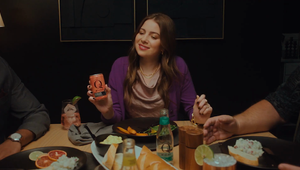
Why People “Will Continue to Be the Soul” of Production, Even as Technologies Advance

Nashville-based production company Gear Seven pushes the limits of creativity, technology and possibility - and innovates like it’s nobody's business. Alongside a non-exclusive roster of directors and production capabilities, Gear Seven offers hardware, LED volume studios and virtual production via its sister companies Shift Dynamics and Arc Studios.
Gear Seven has teamed up with LBB to speak with agency production leaders about innovations in production technology and how it is revolutionising commercial production. This series investigates the importance of education in this area for agencies and brands and offers a fun opportunity to nerd out on all things technical, while sharing memories of their most awe-inspiring and unforgettable moments on set.
Up today is Chad Hopenwasser, chief production officer at Tombras. Chad joined the agency as its first chief production officer in September of last year, prior to which he played a hand in crafting iconic campaigns as head of production at Anomaly, TBWA\Chiat\Day, and Crispin Porter Bogusky.
Despite excitement for the possibilities that advancements in production technology can offer, Chad is hopeful that a human touch remains the industry’s future soul. He speaks to LBB’s Addison Capper.
LBB> Throughout your career – what was the most exciting or groundbreaking piece of ‘new’ kit or technology that was introduced to you and why?
Chad> I wish I could be more flashy with this answer, but I keep coming back to when digital video reached the point that it could essentially replace film (in most cases, apologies to all the film loyalists). It was a huge change that happened relatively quickly, which allowed our industry to move faster, and more affordably in creating similar output. This milestone in the world of digital video also marked the flood of innovation in mobile/consumer camera technology, which has also been a game changer.
LBB> And what are the technologies that you have your eye on now that either are having a big impact on how production is done - or have the potential to change things in a big way?
Chad> Creating high quality, large scale, true 360 video stories is what I currently have my eye on (known as Volumetric Video). Most of what I have personally seen is being used on a smaller scale, in smaller snippets, using the base video for enhancing in post, or just using or leaning into the lower quality image. There are easier ways to create immersive images that are also higher quality than video – the innovation is moving fast and it will be fun to see where it goes. I believe this is less about impact from change and more about telling video stories beyond a flat screen. I’m not sure brands can or should be there consistently at this point, but eventually they will be.
LBB> What piece of kit (big or small and mighty) still makes you feel in awe when on set?
Chad> It’s rarely the equipment that makes me feel in awe when I’m on set. Of course, the technology will continue to evolve and be increasingly impressive, but what I’m constantly in awe about is how the crew uses and adapts to complex equipment. The overall energy on set, big or small, is all about the conceptual work and prep culminating into a few short days, where all of these different talents come together to bring an idea to life. As technologies advance, I am optimistic that the people will continue to be the soul of it all.
LBB> Can you talk us through one or two of the most exciting recent productions that you’ve been involved in that you think had a really interesting innovation or technological aspect to them?
Chad> I think it’s the collection of smaller innovations and technologies that enable our studio at Tombras to continue to up the game on making lo-fi content. Content that delivers on story (it must always deliver on story) but also because of its short life in the world, its production value is based around what one can get done in the time and budget allotted. You could have hours or minutes instead of weeks to create. A new idea developed around an insight in the morning, becomes a video that lives in the world within hours.
While video with words, text or stills have been commonplace for some time, animation, lo-fi effects, music, voiceover, filters, etc. have flipped the video content realm on its head. As far as producing this type of content, sometimes it’s a well choreographed plan of being able to shoot, edit and finish work within our studio. In other cases, it’s one person with a mobile device. These outputs are lo-fi and certainly not right for all creative and media. It’s more about getting better at telling original stories most appropriate for the channel.
LBB> A similar question but it doesn’t have to be recent - what is the time in your career that you’ve been on set / observing a production and been particularly in awe of what the production team was pulling off?
Chad> Anything live is at the top of my list – I love the preparation, nerves, and the idea of putting it all out there without the safety rope we normally have. Anything live is the closest thing we get to being on the production side in my opinion. It takes an aligned team effort all committed to having one great shot during one particular time period. I may be confusing awe with adrenaline rush.
LBB> We’ve spoken about ‘on-set’ things here but you’re also a big fan and user of editing on your phone for Instagram and TikTok. What are your thoughts on that capability as part of this conversation?
Chad> Yes, I am still a big fan of editing via phone as a personal hobby and it only continues to become more user friendly. Since we last spoke, the lo-fi finishing capabilities on mobile have become wildly better from roto, clean up, comp pictures etc. I guess you could say it’s still far, far from what our industry would deem as high end, but to be clear, that isn’t what I am comparing it to. Lo-fi production is improving fast and I’m excited to see when editing starts to extend beyond it.
LBB> Virtual production is growing in popularity in film and TV, as well as advertising now. What are your thoughts about its potential in the advertising space?
Chad> First off, I worry about future producers who want to see the world through this job.
But seriously.
The future of ‘virtual production’ may not be right for every job yet, but it’s likely going to check the boxes of maximising creative output, more affordably and more efficiently in a lot of cases. We are clearly headed in the direction of not always needing to travel to a remote location for authenticity, not needing to make company moves, needing less intricate builds. Having better control over the environment where factors like weather and privacy don't interfere is also a huge advantage. On top of that, there are now endless possibilities of integrating talent more seamlessly into worlds that don’t exist.
You can count me in on the train that believes as production becomes more accessible and affordable, it potentially evolves production pretty significantly.
LBB> It can involve quite a different workflow/process - is that something you feel agencies and brands need to educate themselves on or does it lie with the production company? Why?
Chad> Brands will understandably want to educate themselves in most cases because it’s their investment. The agency, the ones responsible for protecting the investment for the client, should be working closely with the production company making sure it’s the right route. It’s crucial to have a production company and director that lead in that learning and building of confidence and trust in a remote environment. Ultimately, it comes down to getting comfortable with being uncomfortable, knowing how quickly things evolve. But, have a little faith in technology and jump the heck in.
I don’t think it's an all or nothing circumstance either. Maybe I am old school in this thought, but even as the technology becomes more accessible, it doesn’t mean we will never be on location again. Sometimes it will make sense for the creative and other times it doesn’t. My take is to do what is best for the creative.
LBB> With so many platforms to produce for, what’s your preference - to maximise assets across platforms or to produce content that’s more tailored to each content - or some sort of balance? What sort of conversations do you tend to have about this sort of thing?
Chad> Considering big factors such as time and budget, I think being able to customise for each platform is ideal. I think Tombras has been great at understanding the different levels of output that fall between lo-fi & hi-fi content, and customising plans that line up accordingly around budget, time and the creative. Each brand and creative is different, so I think it’s case by case call around these types of variables.
LBB> Quite often production involves trying to solve a problem that’s never been attempted before - and that can mean hacking existing technology or trying to find new technologies. When you get a project that has such technological challenges, how do you and your team like to approach them?
Chad> I think one of the biggest attributes of a good producer is when you don't know how to do something, you figure out quickly who does and surround yourself with those people that are smarter than yourself.
When it comes to technological challenges at Tombras, step one is calling Juan Tubert, our chief technology officer, who has been an incredible addition to the team. Step two is doing an audit and making sure our story is strong enough to use the technology. Some of my great misses were productions that were based around using a new technology just to use it, instead of prioritising the great story first that can be taken to the next level using the new technology. Without the strong story that connects humanity, no one cares about the new technology outside of our industry.













